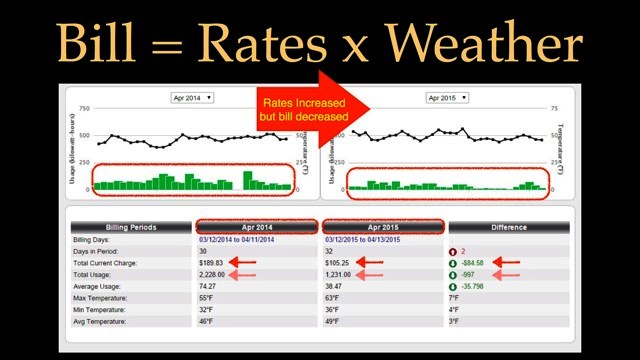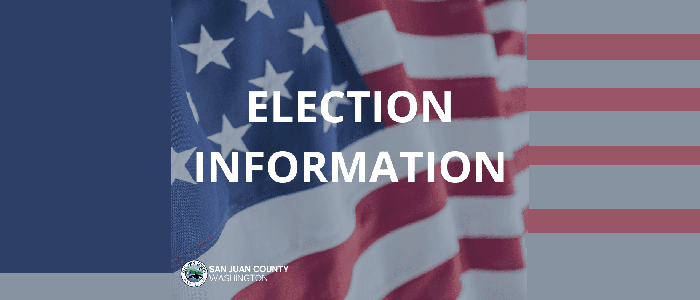Rate Structure Discussion Ongoing
— by Suzanne Olson for OPALCO —

Sample Bill Comparison. Despite the rate increase in February, many OPALCO member bills have gone down because of warmer temperatures and lower kilowatt hour usage, which has led us to a revenue shortfall. What is your bill doing? Do a bill comparison for your own bill on SmartHub (https://opalco.smarthub.coop/Login.html#login:) and find out how your actual bill is trending.
OPALCO leadership pledged to continue to work toward a better rate structure while, in the interim, a surcharge will appear on bills beginning in July to address the revenue shortfall.
More than 20 members representing four islands attended OPALCO’s special board meeting on Thursday, May 28th in Eastsound. As is customary at OPALCO Board meetings, each member was invited to speak to the Board and most did. The topics touched on by member comments were primarily rate fairness, transparency, communication with members and appreciation for the Board’s foresight and progress with broadband.
General Manager Foster Hildreth led the presentation on the factors influencing the current $600,000 revenue shortfall and provided background on rate structure and design. Key concepts addressed were the relationship of weather to rates and the actual impacts on member bills (see attached slide image). In a nutshell, a member bill equals rates multiplied by weather. Warmer weather equals a smaller bill; colder weather equals a larger bill. The revenue shortfall is due to lower than projected sales of kilowatt hours because of record warm temperatures this year. The presentation is available at www.opalco.com (Find Documents/Board Materials/2015/May …).
A number of potential solutions to the revenue shortfall were presented and discussed (use Find Documents to see the May 2015 Board Materials online). The Board will move forward with a surcharge beginning with the July billing period to correct the revenue shortfall. The total revenue amount needed each billing period to balance accounts will be calculated, and the surcharge applied to each member bill based on pro-rated kilowatt hour usage.
“The Board has a fiscal responsibility to keep the Co-op in the black,” said Board President Jim Lett. “The surcharge will meet that need as we further evaluate and research longer-term rate solutions to address the changing landscape.”
Hildreth emphasized that rate structure discussions happen every year to inform OPALCO’s budgeting process. The revenue shortfalls of 2014, and now 2015, are requiring a mid-course adjustment to keep the Co-op’s finances on track.
“We have heard from our members,” said Foster Hildreth, “and we will continue to work towards a rate structure that fairly distributes costs while balancing member priorities such as conservation and energy efficiency.” Hildreth referred to a resource evaluation and low-income member needs assessment that are currently underway and that will inform our ongoing rate structure discussions. Another rate structure shift is expected with the 2016 budget.
This corrective action is required to remain compliant with our federal funder, USDA/Rural Utilities Service (RUS). RUS works closely with utilities to keep financial indicators healthy using a three-year window for review. OPALCO is compliant at this time.
For the latest information about OPALCO, go to: www.opalco.com; sign up for our email newsletter (https://www.opalco.com/about/email-signup/); and follow us on Facebook (Orcas Power & Light Cooperative) and Twitter (@orcaspower). OPALCO is our member-owned cooperative, powering more than 11,000 members on 20 islands in San Juan County since 1937.
**If you are reading theOrcasonian for free, thank your fellow islanders. If you would like to support theOrcasonian CLICK HERE to set your modestly-priced, voluntary subscription. Otherwise, no worries; we’re happy to share with you.**








Now that we all recognize the true costs of Broadband, why doesn’t the membership just democratically vote on it? Yes or no. ?
It’s ironic that the more people conserve and the less that energy is wasted, the higher the bill will be. What kind of incentive is that to treat our planet better?
Neil, yes, there is much irony in all this.
Each month, even if we consume half the energy we normally would, we still need to pay the cost of the 20 island grid, maintenance crews, customer care, and energy services of the co-op. Those “fixed” costs don’t go away just because we use less.
For some ways to save money on energy and care for the planet, think about checking out the energy fairs coming to San Juan, Orcas and Lopez Islands. Look me up and let’s talk energy. I will be by the gray Nissan Leaf electric vehicle.
From what Jay says and what we are all witnessing this means if more people conserve energy then my bill will be more no matter what because we have to pay for all those things he mentioned. OPALCO is collecting less when it comes to Kilowatt hours because of warmer weather and conservation so that lost revenue has to come from somewhere. With this new distribution the low income and conservationists take on the majority of the increase.
With this in mind I would like my co-op, OPALCO to discontinue giving grants out or any type of compensation to encourage “going green” or doing anything to cut electrical usage. I need people to use more Kilowatt hours not less.
Ms. Olson has managed a very smooth article designed to gloss over the problem and leave the most important question for ratepayers unanswered.
The problem: even with a shortfall in 2014 and climate change an acknowledged reality, the OPALCO board failed to plan appropriately nor to save a cushion in past years – a lack of fiscal responsibility at the least.
The question: So what exactly will this “surcharge” cost your average homeowner and on what parameters will it be based? Does the person who historically heats with wood or who historically is not here in the winter, and therefore not presumably part of the previous equation, pay the same as those whose electric heat fluctuations are being blamed for the shortfall? Are those with a 40ft singlewide going to be hit with the same fee as the owners of a 6000 sf megahome? Hey, how about we hit the real culprits: shall we just pin all the costs on the those that saved the most energy in the last two years?
While it’s nice verbage, part of a “fair rate structure” is the ability of consumers to plan their purchases to match their budgets. If the local grocery came back to you today and said “oh, you know those steaks on sale last February you treated yourself to because you saved so much on the toilet paper on sale: we made a mistake, we didn’t make enough money this winter, so we need you to cough up all those “savings” now.” – exactly how fair does that pricing scheme sound?
Darlene, indirectly, makes a good point. While we acknowledge the fact that the earth needs us to use fewer fossil fuels – currently the way most “new” energy is created – OPALCO, and possibly every other public utility, has failed to adequately come to grips with the problem she states so concisely (and I hope, tongue in cheek). Perhaps centralized distribution of power has joined the buggy whip in economic relevance. Perhaps our electric company needs to look at how it and we islanders can transition cost-effectively into a local generation and maximized conservation energy system.
Barbara, Darlene,
Look me up at the energy fairs. Let’s talk energy. I will be by the gray Nissan Leaf.
Also, there will be a number of exhibits on local solar, solar home tours, and community solar for home and business.
And what good does it do to save ?
So we need to use more in order to save ?
Quite a mix message here and the bottom line
we pay more.Or I could spend a lot of money
installing solar panels on my home and how
would this save me money ?
Hope Jay has some answers or solutions !
Jay,
Didn’t I read that the average OPALCO bill has gone down, year upon year? So what’s this I read about paying more?
And doesn’t most of the power we use on Orcas come from hydro? So what’s this I read about using fossil fuels?
Anyway, I’ll look forward to seeing you at the fair. I’ll be driving the silver Leaf!
s
There are two elements to a budget, revenue and expense.
A few years ago, the Orcas island School District convened a Budget Advisory Committee of some 6-8 people to review the School’s budget, in detail, to find ways to trim unnecessary costs. The process was superbly successful. Ironically, Nancy Loomis of OPALCO was on that committee. It would seem to me that OPALCO should do likewise and work to operate a more efficient organization and minimize the need to continue raising rates more as we all try to conserve and cut our kilowatt usage.
The continued increase in rates creates a death spiral in that the organization just can’t catch up. Those folks that are so concerned about this need to dig into the budget and find out if savings are possible.
Is it true or not that the spending on the new broadband infrastructure and the purchase of Rock Island caused OPALCO to default on some statute with its’ creditors and thus cause the creditors to demand quick money from the CO-OP?
Is the weather really the culprit here, or is it mismanagement of funds? Hum?
Hi, Theresa Haynie for Opalco. No, creditors are not demanding quick money from Opalco. Our loan covenants do require that we maintain a certain margin, which with revenue shortfall due to a warm winter and spring we were unable to do.
Tha Rock Island purchase did not drive down revenues, and has no impact on our loan agreements. Regardless of next steps in rate adjustment, Rock Island Communications continues to serve its customers and pay for its use of the Opalco backbone.
At the next general meeting, GM Hildreth should present the same level of detail about the difference between budgeted expenses versus actual expenses over the past eighteen months as he did for budgeted revenues versus actual revenues. Members of the audience asked to see these data but were blown off by Hildreth.
Similarly, members have been asking for some time to see a detailed breakout of electricity-related costs and revenues versus broadband costs and revenues in the OPALCO budgets.
It’s time for the Board to be responsive to these two standing requests from the membership.
With regard to the need to meet certain debt covenants, we hear a lot about ‘revenue shortfall.’ Let’s pause for a moment and look at publicly available data, some of which may surprise you.
At the end of 2014, OPALCO’s TIER (times interest earned ratio) fell to 1.13. A ratio of 1.25 or greater is required to be in compliance with debt covenants. Specifically, this is required by OPALCO’s RUS lender…essentially the federal government via the USDA.
OPALCO’s April 2015 board minutes indicated that a CAP (corrective action plan) was being prepared to address the out of compliance 1.13 TIER. Little detail was publicly provided beyond saying the CAP would address the reasons for the 1.13 TIER result and present a plan to correct the ratio. One can reasonably presume that recent rate surcharge discussions are one result of the CAP.
What is TIER anyway? Specifically, it is a company’s EBIT (earnings before interest and taxes) divided by interest expense. This is a simple math exercise, but what does it mean? TIER is a measurement of an entity’s ability to service the debt it has taken on. As such, the minimum RUS ratio reflects a reasonable endeavor by OPALCO’s lender (the federal government) to ensure that future debt payments will be made and a potential default avoided. (n.b. defaulting on a minimum ratio requirement and defaulting on the debt itself are NOT the same thing)
So OPALCO’s 1.13 TIER is telling us, and telling OPALCO’s lender, that the future ability to service debt is in jeopardy. For reference, OPALCO’s 2010 through 2013 year ending TIER numbers were: 3.21, 5.27, 2.07 and 2.24.
Again, TIER is a measurement derived from earnings (revenue minus expenses, excluding taxes and interest) and interest expense, i.e. how much the debt service is costing the entity. OPALCO is repeatedly telling us that revenue shortfalls are driving the current crisis…let’s pause to look at actual data.
While it is true that 2014 revenue failed to meet the 2014 budget, 2014 revenue INCREASED from 2013. (In fact, revenues increased year-over-year for all three sub-groups: residential, commercial and other) The actual numbers: 2014 $22,029,025 vs 2013 $21,431,278. So the first takeaway here is to realize that when OPALCO talks about revenue shortfalls vis-à-vis the need to submit a CAP, they are talking about shortfalls against their budget, NOT against actual results. 2014 revenues saw an actual 2.2% increase year-over-year. Calling a 2.2% increase a shortfall is sophistry worthy of the ‘other’ Washington. Perhaps there are K Street jobs waiting for some people here, but I digress…
So 2014 saw a 2.2% increase in revenue. What about expenses? 2014 operating expenses increased significantly: 2014 $20,901,493 vs 2013 $19,906,881. That’s an increase of $994,612, or 4.9%.
In fairness, the biggest ‘miss’ on the expense side on 2014 appears to be cost of power, largely out of OPALCO’s direct control…and this brings us to an important point. It is TRUE that OPALCO and other utilities face unprecedented challenges going forward. Centralized power-gen and grid maintenance costs are poised to increase over time while the capital costs of renewables and energy efficiency will trend downward…very soon, the traditional maths of utilities will no longer work, yet the need for centralized power-gen is not going away any time soon. It’s a complicated and expensive problem for any utility to navigate through to the future. Add in the unique costs we have here directly related to our Salish Sea island infrastructure, and the path forward becomes even more difficult.
More than a few utilities around the US will wind up as wards of the state as a result of these challenges. There’s no reason yet to believe that will happen here. But while it’s reasonable for OPALCO to expect open minds to these challenges from members, it’s also reasonable to expect more sophisticated transparency from OPALCO beyond the ubiquitous cry of climate-driven revenue shortfalls. The current idea on deck, a revenue true-up where budgeted revenue = actual revenue is preposterous for a number of reasons, but that is for another forum and another discussion.
OK, back to TIER. We’ve looked at revenue and expenses for the EBIT side of the equation. What of interest expense, the other major value? Interest expense also rose dramatically in 2014: 2014 $908,934 vs 2013 $786,193. That’s an increase of $122,741, or 15.6%. Also consider that interest on long-term debt from 2010 to 2013 came in respectively at: $684,822, $733,675, $759,686 and (2013) $786,193.
It’s not hard to find the culprit here. OPALCO’s year ending 2014 long-term debt liability was $24,987,266 compared to $17,558,365 for 2013. That’s a WHOPPING $7,428,901 increase from 2013, or 42.3%.(!) Consider long-term debt liabilities from 2010 to 2013: $12,096,608, $14,318,323, $15,462,363 and (2013) $17,558,365. This increase appears to be unprecedented, at least in recent history. Note that more debt is certainly ahead as sub-marine cable replacement capital projects commence. Continued misses on things like TIER floors will undoubtedly raise OPALCO’s cost of capital for these already expensive future projects – plainly spoken, this could mean significant and unexpected additional costs for the members.
What could be driving such a non-trivial increase in debt? Could it be the warming weather? Could it be a shortfall? No, it’s almost certainly related to a capital project. So, could it be broadband? This seems like a leading candidate as an expensive capital project that is both new and in range of a $7 million loan. It’s difficult to discern for certain with publicly available information.
As an illustrative exercise though, let’s assume for the moment that the dramatic increase in debt is indeed related to broadband; broadband which OPALCO regularly tells us is paying its own way. (but while not delivering, even minimally, to their own forecasts…but that is yet another topic for another forum/time) With this assumption in play, let’s further assume that 2014 interest expense did not increase by 40%+, but instead by 4.7%, basis recent historical data. First we need 2014 EBIT…we know interest expense and TIER, so math tells us EBIT is $1,027,095. So let’s calculate TIER again with EBIT (conservatively, keeping it constant) and an interest expense of 2013 + 4.7%. We have 1,027,095 / 823,144 = 1.25. It’s close, but there is now NO TIER covenant default in this scenario, even with disappointing revenue and operating expense results. Does this mean that broadband related debt is pushing TIER below minimum requirements? And if so, is by extension driving the need for the upcoming surcharge? Maybe, only OPALCO has the granular data to know for sure.
A few suggestions for good faith transparency:
– Publish the CAP report submitted as a result of TIER falling below its minimum threshold.
– Solicit the opinion of an independent auditor to weigh in on the impact of broadband on utility finances, specifically with regard to rates and future cost of capital for expensive projects like sub-marine cable replacement.
– Expand the discussion on rates to examine the utility’s structure. Is a non-regulated utility the best structure going forward? Broaden the stakeholder groups currently involved in this dialogue.
Thank you Alex for one of the first presentations by anyone that makes ANY kind of sense.
Perhaps the 4th action item on your list should be: have Alex write an explanation.
I think Alexander Conrad’s comment deserves to be an article in Orcas Issues so everyone can see it. Not everyone follows the comments.
If folks are interested in how different possible rate structures impact OPALCO residential members who use different amounts of electricity, check out:
https://www.youtube.com/watch?v=MtgCMEkLHSc
It’s a 6-minute tutorial for a spreadsheet (link available on youtube page) that allows anyone to explore distributional effects of different options.
Just to be clear – OPALCO remains IN COMPLIANCE with our lender, USDA Rural Utilities Service. The rate structure change, the corrective measure in the surcharge – and our ongoing work toward a rate structure that meets our evolving needs – are all part of the corrective action required to REMAIN compliant – as well as financially healthy. RUS understands the volatility that all utilities are subject to and bases compliance reviews on a three-year window to allow for corrections in course.
Suzanne, I was very clear to point out that missing a ratio requirement and defaulting on debt are NOT the same thing. Where is the claim that OPALCO is not in compliance with its lender?
You assert that OPALCO is “financially healthy.” That’s a subjective smiley face on a difficult situation. The fundamental reason that minimum ratios are required is in fact to measure financial health OBJECTIVELY. No, OPALCO is not in default on these loans, but missing ratios when you’ve just taken on $7 million (in context, a 42% increase from the previous year alone) in unprecedented debt is indeed a canary in the coal mine, and with good reason!
A question: Do you define “volatility that all utilities are subject to” to include a substantial debt load to enter into a non-core new business?
Suzanne’s recapitulation of the special board meeting left out that several members stated they thought the board should consider restraining the expenditure side rather than constantly pushing deeper into our member’s pocketbooks to raise the revenue side of the equation.
One member stated to the board how she was financially stressed by the repeating billing increases and that she makes responsible demand choices on our system by doing things like laundry after midnight.
While the February 12-percent system billing increase came with the claim we had a $1.4 million shortfall due partly to reduced energy sales to our members it is important to note that there was a $1.65 million over budget expenditure on Underground Distribution Cable Replacement in 2014.
This appears to coincide with the board’s announcement that it would accelerate its broadband deployment efforts. Management has stated that when it opens a ditch for distribution cable it will put conduit for or with optical fiber cable in the ditches as well. In 2013 $925,000 was spent on underground distribution cable replacement and in 2014 the board had budgeted $1.55 million, but then spent $3.2 million instead.
This is all available in the 2014 year end financials “Capital Projects Budget” page 11, here https://www.opalco.com/wp-content/uploads/2015/03/March-2015-2014-Year-end-financials.pdf
There is a note that some of this over budget expenditure was driven at least in part by “Henry Island Submarine/Bored Cable – Extensive environmental”. There are a handful of full-time residents on Henry Island.
One co-op member suggested to the board that perhaps a member’s share of the facilities charge should be partly dependent on density of the service area they are in or its remoteness.
It appears to me that the board is accelerating underground distribution cable replacement in direct demand with its desires to increase the optical fiber network it is constructing for broadband and telecom. And broadband users do not appear to have to pay for their use of the “grid control” backbone network. Essentially a minority of broadband users are getting treated to a partial free ride by all our members.
These board choices put very significant burdens on our members’ pocket books.
I suspect that the $1.4 million shortfall would not have pushed the billing increases so high had there been adjustments in the rate of optical fiber deployment and distribution cable replacement and had not the purchase of the $700,000-$800,000 spent on the wireless spectrum purchased from Paul Allen’s Vulcan Wireless been paid for out of our cash reserves. Then there was the surprise purchase of Rock Island for a claimed $500K and $7.5 million in pass-through loans needed to capitalize Island Network (dba Rock Island Technology Solutions) as a new for profit OPALCO wholly-owned subsidiary.
$2.9 million of that $7.5 million consumer broadband capitalization is committed for this year alone. $4.5 million of that is to be spent between 2015 and 2017 to provide up to $1,500 credits to incentivize broadband subscribers to connect to the network. Just to pay the principal back to our non-profit grid-side operations will require 6.25 years for each broadband subscriber that takes advantage of the credit incentive. And it will take longer when you add in the planned 7 percent interest our energy members will be paying to service those loans. As far as I can tell there is no guarantee that those credits will be collected if the owner sells the property well before the repayment occurs.
Additionally, in 2014 the board decided to have management hire a broadband manager to head up Island Network but that expensive position did not work out and that manager departed after 6 months. I believe that expensive mis-step was charged to the energy grid side, as well.
At the 2014 September board meeting the board was informed by management that there was a possible 2014 shortfall between $500,000 – $800,000. This was well before the tariff change of last February. One wonders had the board acted more quickly could the issues with our loan covenants and the remedial corrective action plan required by the RUS been avoided?
Keep in mind our board decision making took our long-term debt from $12.1 million in 2010 to $25 million by end-of-year 2014 (page 9 of the same link above).
So the problem is not just lower energy usage or revenue shortfall. Consumer broadband & telecom decision making by the board seems to be driving the need for billing increases and significantly altering our debt structure as well.
I believe our board needs to make adjustments in its expenditures and reconsider the 4.5 million in pass-through loans it is placing on our energy members’ capital to incentivize broadband subscribers. Those are costs that show up on our power bills to benefit a minority of our members who will want or can afford the broadband product.
I believe we need competitive broadband choices that don’t burden our energy members’ pocketbooks. Our board should have the broadband subscribers pay their equitable share of the marginal capital costs and maintenance of our expanded grid control backbone network being sized for consumer broadband and telecom use.